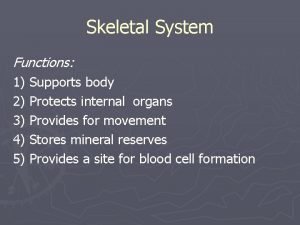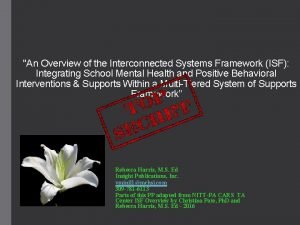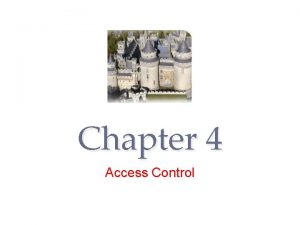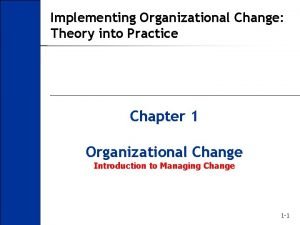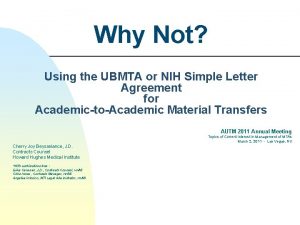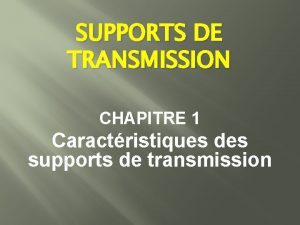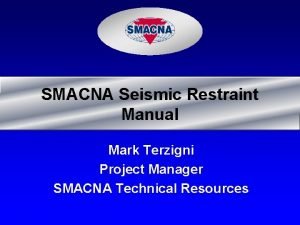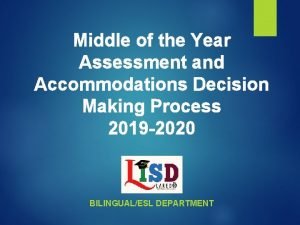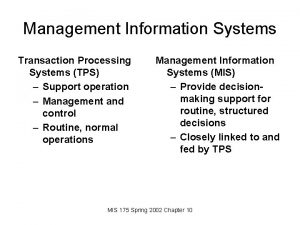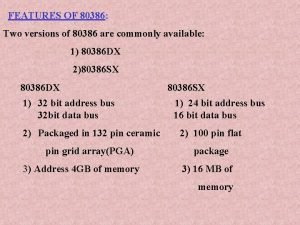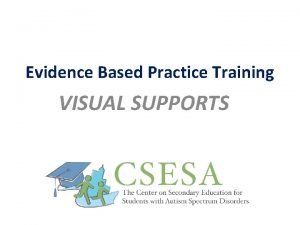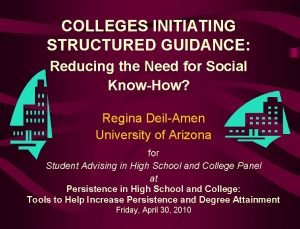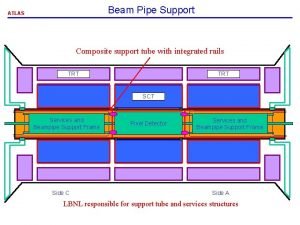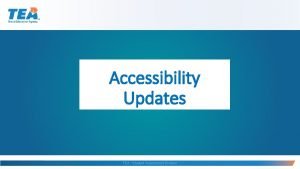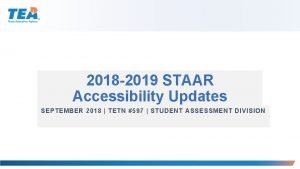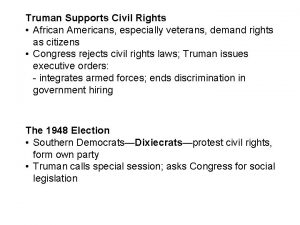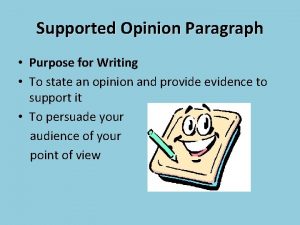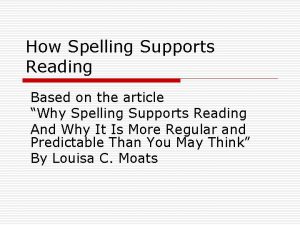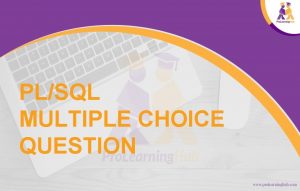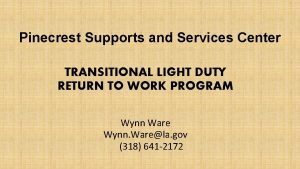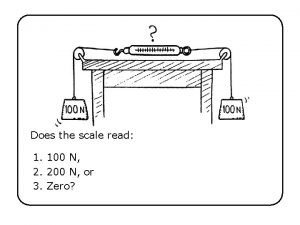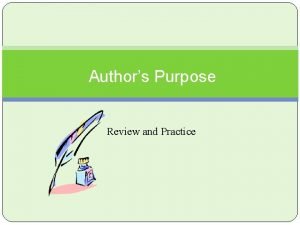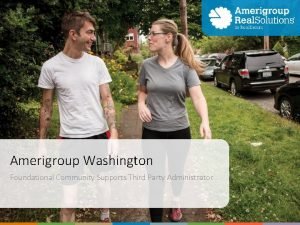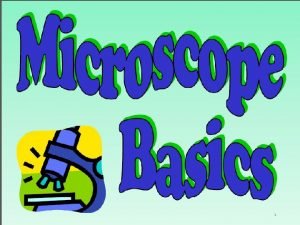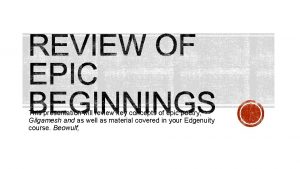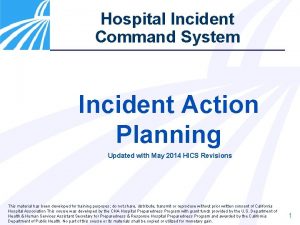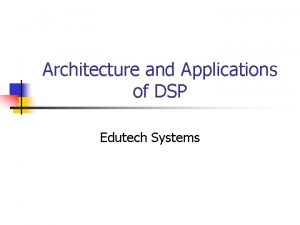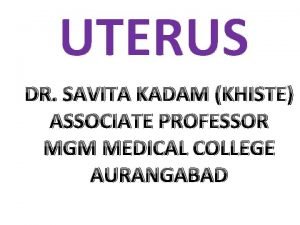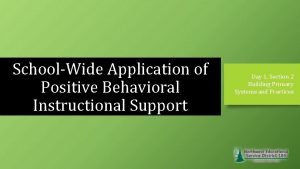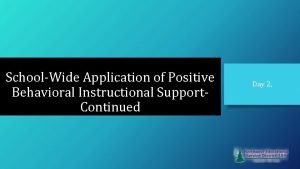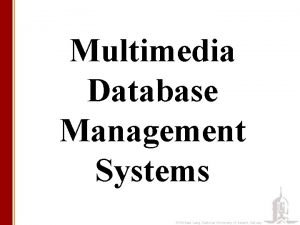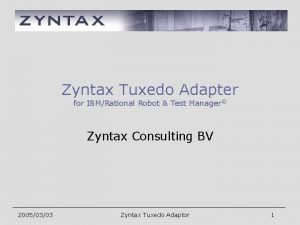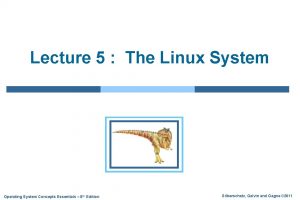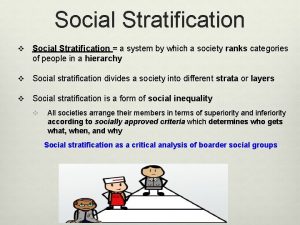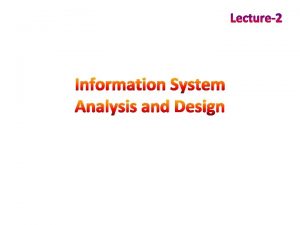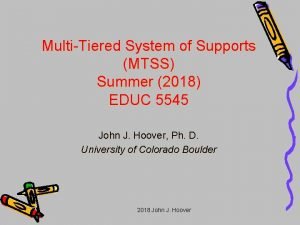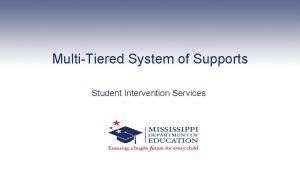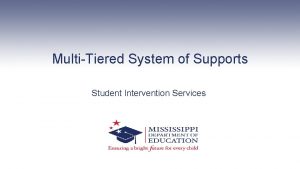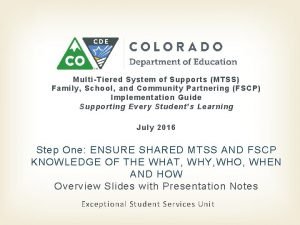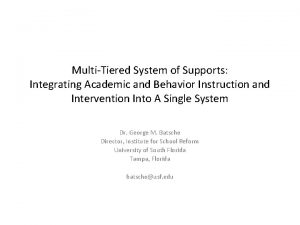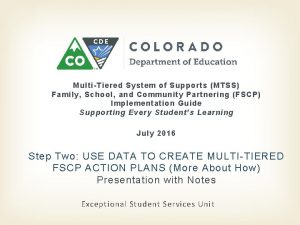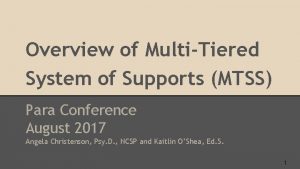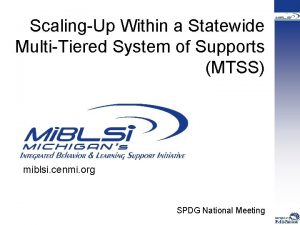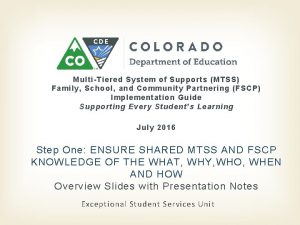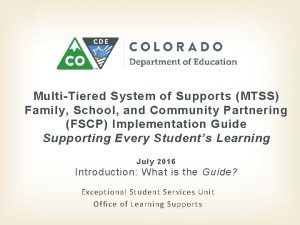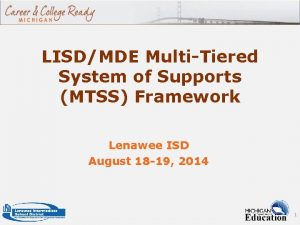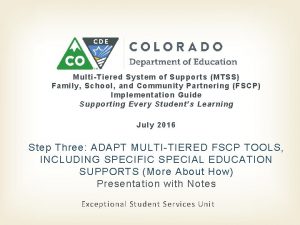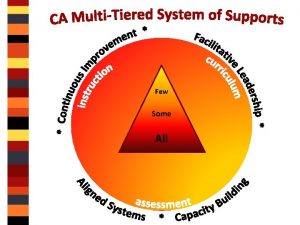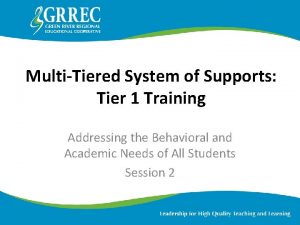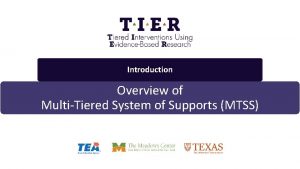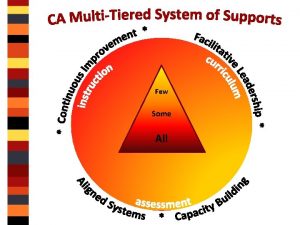Implementing a Multitiered System of Supports at the


































































































































- Slides: 130

Implementing a Multi-tiered System of Supports at the Secondary Level Amber Brundage Beth Hardcastle Kelly Justice Jayna Jenkins January 28, 2016 Boca Raton, FL February 18, 2016 Tampa, FL February 2, 2016 Panama City, FL February 23, 2016 Lake City, FL

Access materials: http: //floridarti. usf. edu/resources/training_modules/secondary_mtss/day 1/index. html Wifi passcode:

House Keeping • • • Restrooms Breaks Lunch Door Prizes Agenda/Handout Packet Handout icon on slides

Learning Objectives Participants will: • Understand that an effective tiered system of support at the secondary level can improve graduation rates; College/Career Readiness • Increase understanding of the importance of including UDL components in the design of instruction • Increase knowledge related questions which may guide data analysis • Increase knowledge related various data sources that can inform instruction • Consider their school’s or district’s system of assessments and identify areas for potential improvement

Learning Objectives Participants will: • Understand relationships between beliefs, practices and provision of learning opportunities • Understand infrastructure elements needed to support provision of additional learning opportunities • Understand scheduling options to support the provision of additional learning opportunities

Training Norms PLEASE… • Silence cell phones • Return from breaks and lunch on time • Respect others who are speaking • Speak up when you are speaking • Limit side conversations • Sit still • Keep your hands to yourself

Introductions Teams: Please identify a song title that you think best reflects your school’s (or district’s) approach to implementing MTSS at the Secondary level! School/District Administrators: Introduce yourself, identify your district and school, introduce your team members, and tell us your team’s song title

Connect with Us! #Secondary. MTSS Florida’s Problem-Solving/Response to Intervention Project – – http: //www. floridarti. usf. edu/ Email: rti@usf. edu Facebook: flpsrti Twitter: @flpsrti Florida Positive Behavioral Interventions & Support Project – – http: //flpbs. fmhi. usf. edu/ Email: flpbs@fmhi. usf. edu Facebook: flpbis Twitter: @flpbis 8

College and Career Readiness: THE IMPORTANCE OF MTSS AT THE SECONDARY LEVEL

Compelling “why’s” • • • Graduation rates: Celebrate Hidden graduation rates: Not good Impact of drop-out rates--$$ “Expectations Gap” College and Career Ready (CCR) Policy Importance of 9 th grade transition Role of Middle School in drop-out prevention Addressing “All students can learn”


www. fldoe. org

“We can, whenever we choose, successfully teach all children whose schooling is of interest to us. We already know more than we need to do that. Whether or not we do it must finally depend on how we feel about the fact that we haven’t so far. ” (Ron Edmonds, 1982)

“Hidden” Graduation Rates • More than 1100 high schools serving over 1. 1 million students fail to graduate 1/3 or more of students each year (all 4 ed. org, 2012) • Primarily impacts low income and students of color • 124 Florida high schools have grad rates at/below 60% (2008 -10 avg. ); 60 high schools have grad rates at/below 67% (2012) • Numbers have declined over time—schools CAN make significant growth


Florida Graduation Rates www. fldoe. org

www. fldoe. org




Economic Impact of Dropping Out… 83, 500 students did not graduate in Florida in 2011, resulting in: • Lost life-time earnings of $9. 5 billion Had just half of those students graduated: • $1. 1 billion in increased home sales • $50 million in increased annual auto sales • 4000 new jobs and $597 million increase in GSP • $34 million in increased annual state tax revenue (Alliance for Excellent Education, 2012)

Expectation Gap--Achieve • Defined as when “end-of-high-school” expectations are not aligned with “real-world” expectations • Limited employment opportunities • Led to high rates of remediation at twoyear/four-year colleges • Since 2005, Achieve tracks states’ progress in adopting CCR policies

Career and College Readiness Students are considered “college and career ready” when they have the… • Knowledge • Skills • Academic preparation …Needed to enroll/succeed in entry-level, credit-bearing post-secondary course-work without need for remediation…or… …Qualify for/succeed in post-secondary job training/education for chosen career

Team Talk With your table-mates, define/provide examples for these components of CCR: Knowledge Skills Academic Preparation Is ready for College and ready for Career the same thing?

Policy Considerations: • Florida Law – Senate Bill 850 • Achieve (2005) – States must have comprehensive approach to CCR and ensure policy and practice alignment across graduation requirements, assessment, accountability • Every Student Succeeds Act (ESSA) – States must set long term goals for 4 -yr grad rates; measures of interim progress – States must identify all HS’s with grad rate at/below 67% – State planning to strengthen transitions from MS to HS and HS to post-secondary

Importance of 9 th Grade Transition Successful completion of 9 th grade is a significant indication of on-time graduation and enrollment in college/post-secondary education and training. (Mac. Iver, Epstein, Sheldon, Fonseca, 2015)

9 th Grade Transition: Challenges • Students not prepared for high school • Organization of high school climate/culture (Neild, 2009) • Parent participation/family engagement • One course failure: probability of graduation by 20%; two failures: by 50% (Mac. Iver et al. , 2015)


Florida Senate Bill 850 • Creates a new middle grades early warning system to identify students who are at-risk of not graduating from high school. • Requires that a school’s child study team or similar team convene when a student exhibits two or more early warning indicators for dropout prevention and academic intervention programs. • Requires public schools that includes any of the middle grades to annually report information and data on the school’s early warning system in the school improvement plan.

Early Warning Indicators Identified in SB 850 • Students are considered “off-track” by meeting the criteria for one or more of the following required indicators: – Attendance below 90% (18+ total days)* • Does not differentiate excused or unexcused absences or absences due to suspensions • *Consider time of year – One or more suspensions (ISS or OSS) – Course failure in ELA or math • Semester grades – Level 1 on state-wide, standardized assessments in ELA or math • Includes all students taking Florida Alternate Assessment • Districts may elect to use other indicators validated: • Internally • Externally

And lastly—compelling why’s… If we believe/espouse “All students can learn”… 1) How do we make that a reality? 2) Are there contingencies attached? 3) Are there situations where we don’t believe it to be true? 4) What plans/strategies do we have in place when a student/group of students is not learning?

Turn and Talk Scenario: A student is entering 9 th grade who is reading at a 4 th grade level. How could you structure this student’s schedule so that s/he is provided Tier 1 (e. g. , UDL), Tier 2, Tier 3 support while still earning credits toward graduation?

Universal Design for Learning

Myth of Average

UDL Implementation Designing a curriculum that allows for more intensive, accessible, and engaging instruction will require instructional teams and leadership teams to regularly communicate regarding: • Support and resources needed to build and maintain effective teams and teaming practices • Strategies and supports that effectively support student engagement and learning • Resources required to implement UDL strategies

UDL Guidelines

Moving this forward… • Build consensus through successes, data, shared concerns, teacher leaders • Harness power of “collective intelligence” • Encourage and reinforce commitment • Honor the creative capacities of school teams • Work within existing amounts of time and funding • Look in the mirror (Du. Four et al. , 2004)

Whatever it Takes: Common Threads • • Clarity of purpose Collaborative culture Action orientation Commitment to continuous improvement Focus on results Strong principals who empower teachers Facing adversity, conflict, anxiety (Du. Four et al. , 2004)

Turning challenges into opportunities! “Fortune favors the experimental mind” (Mike Schmoker, 2004)

Data Sources to Inform Tiered Instruction

What Data? Well, what’s your question? “Organizing data use around essential questions about student performance is a powerful strategy for building data literacy. ” (Ronka, et. al. , 2008)

When questions drive data analysis… Educators can: • Focus on what’s most important • Identify the data they need to answer the questions • Use the questions as a lens for data analysis and interpretation (Ronka, et. al. , 2008)

Consumers of Data • • • District Level Strategic Planning Teams School Improvement Teams School-based Leadership Teams Problem Solving Teams Departmental/Couse-alike Teams And PLCs!

PLC “Crucial Questions” 1. What do we want each student to learn? (Florida Standards and School-wide Behavioral Expectations) 2. How will we know when each student has learned it? (Assessment) 3. How will we respond when a student experiences difficulty in learning? (Intervention) 4. How will we respond when students have already learned it? (Enrichment) (Adapted from Du. Four, 2004)

Aligned Inquiry

4 -Step Problem Solving

Tier 1 Questions 1. What percentage of our students are meeting expectations? 2. Which students will require additional intervention? 3. Are Tier 1* interventions effective? 4. To what degree is instruction being implemented with fidelity? * Interventions or core changes designed to target all students

Tier 2 Questions 1. Are students who receive supplemental supports improving? 2. Which students are struggling despite the provision of effective supplemental instruction? 3. To what degree is instruction being implemented with fidelity?

Tier 3 Questions 1. How is the student responding to intensive intervention? 2. To what degree is instruction being implemented with fidelity?

Assessments Help Answer Our Questions • Screening – Identifies students in need of additional support • Progress monitoring – Measures student progress toward learning goals (e. g. , Formative Assessment) • Diagnostic – Identifies skill strengths and deficits • Outcome – Measures progress students made toward learning standards

Turn and Talk What processes for data review are currently used by educators at your school(s)? • • PLC crucial questions? Problem solving? Data analysis scripts/protocols? Other?

Gallery Walk 1. Brainstorm course assessments as a team and record on chart paper (10 min. ? ) 2. Post your charts 3. “Gallery Walk”- Review the charts of other teams. Note ideas and follow up questions! (15 min. ? ) 4. Discuss as a whole group

You will need… • Teamwork • Focused brainstorming • 3 pieces of chart paper (one for Math, one for ELA, one for Behavior) • Marker District team participants please join a school team!

On Your Chart Paper… School(s)/District name List name Math or ELA or Behavior List Math, ELA or Behavior (one chart paper for each!) List examples of Examples of: assessments consistently used Screeners at your school Diagnostic measures Progress monitoring tools (Include formative assessments!) No abbreviations, please!

DATA SOURCES ACROSS CORE CONTENT AREAS

BEHAVIORAL EXPECTATIONS DATA TO INFORM DECISION MAKING ACROSS TIERS

Courtesy of Florida PBIS “Big 5 Reports”- Examining ODRs Problem Behavior Monthly Referral Rate Location Time Admin Decision

Referrals by Location WHERE: Readi ng Block Referrals by Time WHEN CLASSROOM TIER 1 CUSTOM REPORTS OFFER PRECISION: CLASSROOM Referrals by CONTEXT, 9: 00 - 11: 30 During Large Group Instruction CLASSROOM LARGE GROUP INSTRUCTION Referrals by MOTIVATION, 9: 00 - 11: 30 To Avoid the Activity Courtesy of Florida PBIS

Screening Is it the fish… Referrals by Students Referrals by Staff …or the water? Courtesy of Florida PBIS

Screening for Internalizing Behavior • Teacher nomination • Rating scales http: //flpbs. fmhi. usf. edu/tier 2/Teacher%20 Nomination%20 Form. pdf http: //miblsi. cenmi. org/Mi. BLSi. Model/Evaluation/Measures/Student. Risk. Screening. Scale. aspx

Tier 2 Progress Monitoring Daily Percent of Points Earned Courtesy of Florida PBIS

Evaluate Progress Across Interventions Courtesy of Florida PBIS

Individual Student Reports Courtesy of Florida PBIS

Other Methods for Monitoring Student Behavioral Progress • • Behavior Report Cards Behavior Rating Scales Direct Observations Permanent Products

Adapted from Crone, Horner & Hawken (2004) Points Possible: ______ Points Received: ______ % of Points: ______ Goal Achieved? Y N Daily Progress Report Name: _____________ Date: ______ Rating Scale: 3=Good day 2= Mixed day 1=Will try harder tomorrow GOALS: SCHOOL-WIDE EXPECTATIONS/Behavior Goals 1 st 2 nd 3 rd 4 th L 5 th 6 th BE SAFE Use your anger reducers BE RESPECTFUL Use active listening & problem solving skills BE RESPONSIBLE Complete your hassle log • Average percent of points earned • Number of days must be considered DEMONSTRATE A POSITIVE ATTITUDE Reframe angry thoughts Teacher Comments: I really like how… _______________________________________________________________________________ Courtesy of Florida PBIS Parent Signature(s) and Comments: ________________________

FLPBS Tier 2 Progress Monitoring Tool Go to: FLBPS homepage > Resources > Tier 2 > Progress Monitoring > Spreadsheet

http: //www. flrtib. org/docs/Got%20 Data. %20 Tier%201% nly. pdf


MATHEMATICS DATA TO INFORM DECISION MAKING ACROSS TIERS

Tier 1 Data Sources - Math • • • Early Warning Systems Universal Screeners Common Assessments Curriculum-based Measures District Benchmark Assessments End of Course Exams

Tier 1 Data Sources - Math • Multiple classroom data sources – Textbook/program assessments – Projects – Classwork – Homework – Observation

http: //www. rti 4 success. org/resources/tools-charts/screening-tools-chart

http: //www. cpalms. org/Public/Resource. Collection/Preview/202

http: //www. intensiveintervention. org/chart/progress-monitoring? grade=middle&subject=math

CBM (Curriculum-based Measurement) http: //www. interventioncentral. org/curriculum-based-measurement-reading-math-assesment-tests https: //www. easycbm. com/about. html

ELA (ENGLISH LANGUAGE ARTS) DATA TO INFORM DECISION MAKING ACROSS TIERS

Tier 1 Data Sources - ELA • Early Warning Systems • Historical data • Outcome assessments - “ballpark estimate” (Heller, n. d. ) • Literacy screening • Common Formative Assessments Heller, R. (n. d. ), “Making it a Priority to Assess Students’ Literacy Skills. ” Retrieved from: http: //www. adlit. org/adlit_101/improving_literacy_instruction_in_your_school/make_it_ a_priority_to_assess_students_literacy_skills/

Florida Center for Reading Research – fcrr. org FAIR-FS Initial Screening STOP Word Recognition STOP NO Compute Score Take optional tasks? <. 85? Vocabulary Knowledge YES Syntactic Knowledge Reading Comprehension YES Oral Reading Fluency Oral Response Diagnostic Test Computer Administration Paper/Pencil Administration NO 78 Written Response Additional Diagnostic Test

https: //fsla. fldoe. org/file/3 cb 6 aae 9 -a 5 d 1 -4 f 3 f-9180 -953 b 4 c 909 ba 2/1/flstandards%20%282%29. zip/6 -8. html#tab-5

ELA Progress Monitoring – Unit Assessment – Vocabulary – Daily In-Class Formative Assessment – Homework – In-Class Participation – Observational Data Florida PS/Rt. I Project– PK-12 Alignment Unit

ELA Progress Monitoring Examples • Curriculum Based Measurement – Aims. Web – DIBELS – FAIR FS – Skill-based probes – Easy CBM • FL-ELFAS • Self Monitoring Checklists/Rubrics • Observations Florida PS/Rt. I Project– PK-12 Alignment Unit

SCHEDULING

“When you start with an honest and diligent effort to determine the truth of the situation, the right decisions often become self -evident… You absolutely cannot make a series of good decisions without first confronting the brutal facts. ”- Jim Collins

Beliefs Related to Scheduling • How many times have you heard: – “We don’t have time to provide interventions during the school day. ” – “We would love to provide interventions, but our master schedule doesn’t allow it. ” • Is your master schedule: – An impediment to change? – A tool to help organize time to support students?

Beliefs Related to Scheduling • We have to start with beliefs about: – Purpose of our school – ALL student’s ability to learn at high levels – Our responsibility to ensure that high level learning happens for ALL students • Opportunity to learn versus ensuring learning – The value of job embedded continuous learning for educators (PLC’s) as the key to improved student learning – Purpose of supplemental and intensive interventions

Formula for Learning Constant Variable Targeted Instruction Time Learning Variable Constant Mattos, & Buffum, 2015

“As every past generation has had to disenthrall itself from an inheritance of truisms and stereotypes, so in our own time we must move on from the reassuring repetition of stale phrases to a new, difficult, but essential confrontation with reality. For the great enemy of truth is very often not the lie –deliberate contrived, and dishonest- but the myth- persistent, persuasive and unrealistic. Mythology distracts us everywhere. ”- President John F. Kennedy

Alignment of Beliefs and Practices: PLCs • We have to take an honest evaluation of the extent to which our practices align with our beliefs: – Built-in meeting/collaborative planning time – Shared purpose, direction, values and goals – Collaborative unpacking of standards and identification of learning targets – Development/utilization of common (formative and summative) assessments on frequent basis – Collaborative analysis of assessment data to identify: • Those who have not mastered learning targets • Areas of strength/improvement in instructional practices

Alignment of Beliefs and Practices: Provision of Additional Learning Supports • We have to take an honest evaluation of the extent to which our practices align with our beliefs: – Intervention/enrichment opportunities consistently available to all students in core content areas during the school day • Within core content areas – Adult – Peer learning communities • Separate time – Supplemental and intensive interventions matched to need • Type – Academic – Behavioral – Engagement • Intensity – Time – Focus – Instructional methodology

Turn and Talk • Discuss with table mates the Scheduling “Provision of Additional Learning Supports” Reflection Questions.


“The difficulty lies not so much in developing new ideas as in escaping old ones. ”- John Maynard Keynes

District –Level Infrastructure Necessary to Support Provision of Additional Learning Supports • Infrastructure components must be in place at both the district and the school-level for effective implementation. – Leadership team to determine vision and implementation plan • Collaboration with key stakeholders – Communication of expectations and accountability for provision of additional learning supports within the school day • PLCs as vehicle for continuous improvement • Determine acceptable models for scheduling of intervention/enrichment time K-12 • Middle/High articulation

District –Level Infrastructure Necessary to Support Provision of Additional Learning Supports – Build capacity of staff through professional development • • PLCs Common assessments Data-based problem-solving systems and student-level Intervention and enrichment strategies – Allocation of resources based on need – Determine method of accountability • • PLC notes MTSS plans Observations Principal meeting reports


School –Level Infrastructure Necessary to Support Provision of Additional Learning Supports • Leadership team to determine school MTSS vision and implementation plan – Alignment with district vision and implementation plan • Communication of expectations and accountability for provision of additional learning supports within the school day as a priority • PLCs as vehicle for continuous improvement – During school day • How staff are utilized throughout the day/week • Priority in scheduling students in need of additional learning support considering: – Level of support needed – Composition of classes • Groups are fluid and matched to student need • Involvement of stakeholders: students, parents, community, association

School –Level Infrastructure Necessary to Support Provision of Additional Learning Supports – Access to data sources necessary for problem solving – Build capacity of staff through professional development • • • PLCs Common assessments Data-based problem-solving systems and student-level UDL Intervention and enrichment strategies – Allocation of resources based on need – Determine method of accountability • • • PLC notes MTSS plans Observations Intervention plans Progress monitoring

Turn and Talk • Discuss with table mates the Scheduling “ District and School Infrastructure” Reflection Questions.

State/District Dedicated Time • An understanding of required/dedicated minutes for both adults and students provides starting point for knowing what is flexible and what is fixed. Teachers Fixed Component Allocated Time Contractual Hours Average of 8 hrs/day Planning Time Average of 60 min/day= 300 min/wk Student Contact Time District Dependent

State/District Dedicated Time Student Fixed Components Instructional Time Allocated Time • 900/810 hours per year • 1500/1350 min per year • 135 hours per year for 1 Credit • 45 minutes per day • 67. 5/60 hours per semester for ½ Credit

State/District Dedicated Time Student Fixed Components Allocated Time Graduation Requirements 4 English (I-IV) 4 Math (Alg 1, Geometry*) • Alg 1 A/Alg 1 B double blocks • Liberal Arts Math 3 Science (Bio 1, & 2 labs*) 3 Social Studies (World Hx, U. S. Hx, Govt, Econ - personal finance) 1 PE 1 Fine/Performing Art 1 Online 8 Electives • Intensive Math/Reading/LA • Research • Leadership Skills Development • Personal, Career and School Development • Peer Counseling

INTERVENTION/ENRICHMENT SCHEDULE EXAMPLES

“Better is possible. It does not take genius, It takes diligence. It takes moral clarity. It takes ingenuity. And above all, it takes a willingness to try. ”- Atul Gawande

Additional Learning Support Options: Tier 1 & Tier 2 • Increased instructional time - core content areas are at least 70 minutes achieved through: – – – Addition of minutes to school day Decrease passing time between periods Decreasing lunch Use of Block schedules Electives 45 min • Altered use of instructional time – Daily quick formative assessments • Identify students who have met learning targets and those who have not – Interdisciplinary stretch projects used across all content areas • Students who have met learning targets can work on stretch projects during enrichment time – Use of rolling pre-teach, review, re-teach model • Review/re-teach content from previous day, teach new content, pre-teach upcoming content • Consider use of co-teach model – Core classes have 2 nd adult (support facilitator/Instructional assistant) • Reduce number of sections

Sample Use of Instructional Time (70 min) Time Instructional Focus 5 min Learning target bell work 33 min Direct instruction 5 min Formative assessment 7 min Teacher review assessments and identify those who have mastered learning targets and those that need re-teaching as well as specific concepts for re-teaching 20 min Re-teach concepts to those not meeting proficiency criteria on formative assessments Those who met proficiency criteria on formative assessment work on interdisciplinary stretch project- may be collaborative or independently. Mattos & Buffum, 2015

Middle School Example Plantation Key K-8 School- Monroe County • 20 minutes of every 75 period is designated IE time. Teachers provide IE within the middle school schedule. • We keep changing the “look” to meet more students’ needs. It is always morphing into something else……

High School Example • 4 Double blocks: 100 Min Alg 1 A and Alg 1 B – Agile Mind program – Students selected based on attendance, previous test scores, behavior – Students earn 2 credits by end of the year • Improved Alg 1 EOC proficiency rates over those of students who took Alg 1 B without Agile Mind

High School Example Pasco County- Double Block

Additional Learning Support Options: Tier 1 & Tier 2 Development of additional learning support period • Content area teachers collaboratively determine: – Essential learning targets – Formative assessments (FA) for learning targets • Pre-determined proficiency criteria for each assessment – Assessment days through-out the year • E. G. ~10 common formative assessments throughout the year with ~ 10 days of intervention/enrich time after each • Based on FA data: – Students requiring additional learning supports are selected to attend intervention/re-teach sessions – Students who have met proficiency criteria for learning targets participate in enrichment • All students receive intervention/enrichment across content areas • Priority days for those who have multiple content areas in need of enrichment • Students passing all courses, with no missing work, not requested by another teacher may choose where to spend enrich time (content area, clubs, etc. )

Example of Intervention/Enrichment Options Mattos & Buffum, 2015

Content Area Students/Group Focus Teachers/Group ELA Intervention 20 Targeted sm grp 2: ELA, 1: ESE, 1 Reading Specialist ELA Extension 40 Extension Instruction 2: ELA Math Intervention 20 Targeted sm grp 2: math, 1: ESOL Math Extension 40 Extension activity 2: math Social Studies Intervention 20 Targeted sm grp 2: social studies Social Studies Extension 20 Extension activity 1: social studies Science Intervention 30 Sm grp- hands-on 3: science Science Extension 20 Lab extension 1: science PE 80 Aerobic activity 3: PE Guided Study Hall 100 Tutoring by staff and students 1: social studies, 1: social worker, 2: Tas Guided Study Hall 50 Tutoring by staff and students 1: library teacher, 1: TA Band 50 Band practice 1: band Art 20 Mattos & Buffum, 2015 Extension project Mattos & Buffum, 2015 1: art

Middle School Example- 35 Intervention Period Sugarloaf K-8 School- Monroe County • We use a 35 minute intervention period – at the end of our third period class – Students who are doing poorly are grouped in academic support classes and the other students do enrichment • We created this time in our day by shaving 3 minutes off each class and cutting time off of our homeroom • This was done the year prior during our master scheduling window.

ARMS/EXCEL Middle School Example • ~700 Students – 94% ED – 11% SWD • School Day: 8: 30 am-4: 05 pm – 10 period day- including Homeroom, Flex, Lunch – 15 min Homeroom – 35 min school-wide Flex time- students grouped according to assessment data for intervention/enrichment – Additional interventions occur for those who need additional support during Connections (42 min)

Middle School Example 35 Min FLEX

Eau Gallie High School Anchor Hour • All 1710 students have 55 min lunch/tutoring – Teachers have office hours during first half to meet with students – Check-in stations at beginning of lunch to monitor student movement • Staffed by: Guidance, Admin, Custodial, PE staff – Students can eat anywhere on campus • 9 lunch lines and 2 designated cafeterias – Added 10 min to day – Reduced periods to 47 minutes – Communication/collaboration with all stakeholders: teachers, students, parents, food services, custodial • Reduced D’s & F’s from 800 to 500

High School Example- Anchor Hour

Middle School Example • School Day 8: 55 -4: 05 – ~700 students – 94% Poverty Index – 20% ELL (Spanish) – High mobility • 7 periods (55 -75 min) 35 min lunch – Common grade level planning during exploratory – School-wide Reading intervention/enrichment period – Intervention offered for those in need of additional support during exploratory classes • 2 Intervention Support staff 3 -5 periods • 6/8 Exploratory staff 1 period • 3 Special Ed staff 1 period

Middle School Example- Grade Level Team

Middle School Example- Exploratory Schedule

Middle School Example- Intervention Courses

Additional Learning Support Options: Tier 2 & Tier 3 • Strategic use of learning labs as electives or during lunch for: – Re-teaching – Work completion – Testing supports • Re-takes – Study skills • Mandated focused lunch – Work completion – Tutoring • Adult • Peer – Behavior/social-emotional support – Study skills • Strategic use of homeroom – Behavior/Social-emotional focus – Mentoring – Tutoring – Study Skills • Use of electives time for academic skill development – Small homogenous groupings for specific skills • Based on formative assessments as well as screening/diagnostic s • Mandatory summer bridge programs for at-risk 8 th graders • Mandatory summer school

Case Study Activity • Select an example from the case study packets on your table – – – • • Slides 1 -3 Slides 4 -5 Slides 6 -11 Slides 12 -13 Slides 14 -17 Slide 18 Answer questions 1 -6 on the Additional Learning Supports Case Study document (pg 9 -10 in agenda packet) Report out – – Overview Necessary

Turn and Talk • Discuss with table mates the Scheduling “Intervention/Enrichment Examples” Reflection Questions.

Wrap Up! • Questions? • Evaluation

Thank You! Amber Brundage abrundage@mail. usf. edu Beth Hardcastle hardcast@udf. edu Jayna Jenkins jayna@usf. edu Kelly Justice justice@usf. edu 127

Additional Reading, Resources Allensworth, E. (2013). The use of ninth grade early warning indicators to improve Chicago schools. Journal for Education of Students Placed at Risk, 18(1), 68 -83. doi: 10. 1080/10824669. 2013. 745181 Allensworth, E. M. , & Easton, J. Q. (2005). The on-track indicator as a predictor of high school graduation. Consortium on Chicago School Research, University of Chicago. Retrieved from http: //ccsr. uchicago. edu/publications/p 78. pdf Allensworth, E. M. , & Easton, J. Q. (2007). What matters for staying on track and graduating in Chicago public high schools. Consortium on Chicago School Research, University of Chicago. Retrieved from http: //ccsr. uchicago. edu/publications/07%20 What%20 Matters%20 Final. pdf Allesnworth, E. M. , Gwynne, J. A. , Moore, P. , & de la Torre, M. (2014). Looking forward to high school and college Middle grades indicators of readiness in Chicago public schools. Consortium on Chicago School Research, University of Chicago. Retrieved from https: //ccsr. uchicago. edu/sites/default/files/publications/Middle%20 Grades%20 Report. pdf Alliance for Excellent Education. Below the surface: Solving the hidden graduation rate crisis. Retrieved from: http: //www. all 4 ed. org/wp-content/uploads/2015/Belowthe Surface. pdf Alliance for Excellent Education. Florida fact sheet. Retrieved from: http: //www. all 4 ed. gov Balfanz, R. & Byrnes, V. (2010). Early indicator analysis for Metro Nashville Public Schools. Everyone Graduates Center, Johns Hopkins. Balfanz, R. , Herzog, L. , Mac. Iver, D. , (2007). Preventing student disengagement and keeping students on the graduation path in urban middle-grades schools: Early identification and effective interventions. Educational Psychologist, 42(4), 223 -235.

Additional Reading, Resources Bowers, A. J. , Sprott, R. , & Taff, S. (2013). Do we know who will drop out? A review of the predictors of dropping out of high school: Precision, sensitivity and specificity. The High School Journal. 96(2), 77 -100. Center for Promise, Boston University. (2015). Don’t quit on me: What young people who left school say about the power of relationships. America’s Promise Alliance. Retrieved from: http: //gradnation. org/sites/default/files/DQOM_Short_report. pdf Carl, B. , J. T. , Cheng, E. , Kim, H. , & Meyer, R. H. (2013). Theory and applications of early warning systems for high school and beyond. Journal of Education for Students Placed At Risk, 18, 29 -49. doi: 10. 1080/108246669. 2013. 745374 CAST Universal Design for Learning Resources. Available at: http: //www. cast. org Closing the Expectations Gap— 2014 Annual Report. Retrieved from: http: //www. achieve. org/publications/closing-expectations-gap-2014 Davis, M. , Herzog, L. , Legters, N. (2013). Organizing schools to address early warning indicators (EWIs): Common practices and challenges. Journal for Education of Students Placed at Risk, 18(1), 84 -100. doi: 10. 1080/10824669. 2013. 745210 Davis, A. , Solberg, S. V. , de Baca, C. , & Hargrove Gore, T. (2014). Use of social emotional learning skills to predict future academic success and progress toward graduation. Journal of Education for Students Placed At Risk, 19, 169 -182 Du. Four, R. , Eaker, R. , & Karhanek, G. (2004). Whatever it takes: How professional learning communities respond when kids don’t learn. Bloomington, IN: National Education Services.

Additional Reading, Resources Duncheon, J. C. , 2015. The problem of college readiness. In Tierney, W. G. , & Duncheon, J. C. , (Eds. ), The Problem of College Readiness (pp, 3 -44). Albany, NY: State University of New York Press. Every Student Succeeds Act: Accountability Provisions. (2015). Retrieved from: http: //all 4 ed. org/wp-content/uploads/2015/12/ESSAaccountabilitychart. pdf Every Student Succeeds Act Primer: High Schools. (2015). Retrieved from: http: //all 4 ed. org/wp-content/uploads/2015/12/ESSAPrimer-High. Schools. pdf Fairchild, (2012). Beyond individual at-risk student performance: A new tool to identify school structures systematically producing risk in NYC high schools. Retrieved from http: //annenberginstitute. org/cris/webinars/cris-webinar-tool-to-identify-system-causes-of-risk Florida Problem Solving/Response to Intervention Resources. Available at: http: //floridarti. usf. edu Florida Rt. I: B. Got Data? Take the challenge. Available at: http: //www. flrtib. org/docs/Got%20 Data. %20 Tier%201%20 only. pdf Grad. Nation. (2015). Building a grad nation report: Progress and challenges in ending the high school dropout epidemic. Retrieved from http: //www. gradnation. org/report/2015 -building-grad-nation-report Grad. Nation. 2016 Building a Grad Nation Data Brief. Available at: http: //www. gradnation. org/report/2016 building-grad-nation-databrief? utm_source=newsletter&utm_medium=email&utm_content=Get%20 the%20 data%20 now&utm_camp aign=BGN%20 Data%20 Brief%20 Release

Additional Reading, Resources Hall, G. S. , & Hord, S. M. (2011). Implementing change: Patterns, principals, and potholes. Upper Saddle River, NJ: Pearson Heppen, J. B. , & Therriault, S. B. (2008). Developing early warning systems to identify potential high school dropouts. Washington, DC: National High School Center, American Institutes for Research. Retrieved from http: //www. betterhighschools. org/pubs/ews_guide. asp John W. Gardner Center for Youth and their Communities, Stanford University. (2014). Menu of college readiness indicators and supports. College Readiness Indicator Systems Resource Series. Seattle, WA: Bill & Melinda Gates Foundation. Knowles, J. E. (2014). Of needles and haystacks: Building an accurate statewide dropout early warning system in Wisconsin. Retrieved from: http: //figshare. com/articles/Of_Needles_and_Haystacks_Building_an_Accurate_Statewide_Dropout_Early_War ning_System_in_Wisconsin/1142580 Mac Iver, M. A. , Epstein, J. L. , Sheldon, S. B. , & Fonseca, E. (2015). Engaging families to support students’ transition to high school: Evidence from the field. Retrieved from: http: //www. muse. jhu. edu/journals/hsj/summary/v 099/99. 1. iver. html Neild, R. C. (2009). Falling off track during the transition to high school: What we know and what can be done. Retrieved from: http: //www. muse. jhu. edu/journals/foc/summary/v 019/19. 1. neild. html

Additional Reading, Resources National High School Center. (2012). National high school center early warning system middle grades tool technical manual. Washington, DC: Author. Retrieved from http: //www. betterhighschools. org/documents/NHSC_EWSMiddle. Grades. Tech. Manual. pdf Reeves, D. (2006). The learning leader: How to focus school improvement for better results. Alexandria, VA: ASCD. Technology and Learning Connections. Increasing student achievement through the systemic alignment of technology, policies, and curriculum in a multi-tiered system of supports. Available at: http: //www. tlc-mtss. com
 What system supports the body
What system supports the body Multi tiered system of supports
Multi tiered system of supports Implementing hrd programs pdf
Implementing hrd programs pdf Implementing strategies management and operations issues
Implementing strategies management and operations issues Strategic management chapter 7
Strategic management chapter 7 Chapter 7 strategic management
Chapter 7 strategic management Tripod of pricing
Tripod of pricing Retail management notes doc
Retail management notes doc Designing and implementing branding strategies
Designing and implementing branding strategies Designing and implementing branding strategies
Designing and implementing branding strategies Principle of portfolio assessment
Principle of portfolio assessment Crm project plan
Crm project plan Qsen teamwork and collaboration examples
Qsen teamwork and collaboration examples Challenges of implementing predictive analytics
Challenges of implementing predictive analytics Implementing organizational change spector
Implementing organizational change spector Mis issues in strategy implementation
Mis issues in strategy implementation Is the traditional method of implementing access control
Is the traditional method of implementing access control Problems in implementing portfolio management
Problems in implementing portfolio management Strategic business unit structure
Strategic business unit structure Toyota brand hierarchy
Toyota brand hierarchy Nfpa 1600 standard
Nfpa 1600 standard Implementing organizational change theory into practice
Implementing organizational change theory into practice Ubmta
Ubmta Implementing nfpa 1600 national preparedness standard
Implementing nfpa 1600 national preparedness standard Zpf cisco
Zpf cisco Ch 7
Ch 7 Hát kết hợp bộ gõ cơ thể
Hát kết hợp bộ gõ cơ thể Frameset trong html5
Frameset trong html5 Bổ thể
Bổ thể Tỉ lệ cơ thể trẻ em
Tỉ lệ cơ thể trẻ em Gấu đi như thế nào
Gấu đi như thế nào Tư thế worms-breton
Tư thế worms-breton Hát lên người ơi
Hát lên người ơi Các môn thể thao bắt đầu bằng tiếng bóng
Các môn thể thao bắt đầu bằng tiếng bóng Thế nào là hệ số cao nhất
Thế nào là hệ số cao nhất Các châu lục và đại dương trên thế giới
Các châu lục và đại dương trên thế giới Cong thức tính động năng
Cong thức tính động năng Trời xanh đây là của chúng ta thể thơ
Trời xanh đây là của chúng ta thể thơ Mật thư tọa độ 5x5
Mật thư tọa độ 5x5 Làm thế nào để 102-1=99
Làm thế nào để 102-1=99 độ dài liên kết
độ dài liên kết Các châu lục và đại dương trên thế giới
Các châu lục và đại dương trên thế giới Thể thơ truyền thống
Thể thơ truyền thống Quá trình desamine hóa có thể tạo ra
Quá trình desamine hóa có thể tạo ra Một số thể thơ truyền thống
Một số thể thơ truyền thống Cái miệng bé xinh thế chỉ nói điều hay thôi
Cái miệng bé xinh thế chỉ nói điều hay thôi Vẽ hình chiếu vuông góc của vật thể sau
Vẽ hình chiếu vuông góc của vật thể sau Biện pháp chống mỏi cơ
Biện pháp chống mỏi cơ đặc điểm cơ thể của người tối cổ
đặc điểm cơ thể của người tối cổ V cc cc
V cc cc Vẽ hình chiếu đứng bằng cạnh của vật thể
Vẽ hình chiếu đứng bằng cạnh của vật thể Tia chieu sa te
Tia chieu sa te Thẻ vin
Thẻ vin đại từ thay thế
đại từ thay thế điện thế nghỉ
điện thế nghỉ Tư thế ngồi viết
Tư thế ngồi viết Diễn thế sinh thái là
Diễn thế sinh thái là Dot
Dot Số nguyên tố là
Số nguyên tố là Tư thế ngồi viết
Tư thế ngồi viết Lời thề hippocrates
Lời thề hippocrates Thiếu nhi thế giới liên hoan
Thiếu nhi thế giới liên hoan ưu thế lai là gì
ưu thế lai là gì Hổ đẻ mỗi lứa mấy con
Hổ đẻ mỗi lứa mấy con Khi nào hổ con có thể sống độc lập
Khi nào hổ con có thể sống độc lập Sơ đồ cơ thể người
Sơ đồ cơ thể người Từ ngữ thể hiện lòng nhân hậu
Từ ngữ thể hiện lòng nhân hậu Thế nào là mạng điện lắp đặt kiểu nổi
Thế nào là mạng điện lắp đặt kiểu nổi Supports intensity scale rating key
Supports intensity scale rating key Les différents supports de transmission
Les différents supports de transmission Staar open ended questions
Staar open ended questions Osi network management model
Osi network management model Smacna hangers and supports
Smacna hangers and supports Staar alt 2 justification examples
Staar alt 2 justification examples Characteristics of tps
Characteristics of tps What are content and language supports
What are content and language supports Operating modes of 80386
Operating modes of 80386 Visual supports evidence based practice
Visual supports evidence based practice Structured guidance and supports
Structured guidance and supports Composite pipe supports
Composite pipe supports Tea accessibility features
Tea accessibility features Staar content and language supports
Staar content and language supports Truman supports civil rights
Truman supports civil rights Structure of opinion paragraph
Structure of opinion paragraph Title 22 restricted health conditions
Title 22 restricted health conditions What period is period of activism?
What period is period of activism? How spelling supports reading
How spelling supports reading The pipe assembly supports the vertical loads shown
The pipe assembly supports the vertical loads shown Raceways and fittings
Raceways and fittings Temporary pipe supports
Temporary pipe supports What are the components of accenture delivery suite?
What are the components of accenture delivery suite? Where were the renaissance
Where were the renaissance Supports the body tube *
Supports the body tube * Metacognition and growth mindset supports grit.
Metacognition and growth mindset supports grit. Database trigger will fire when the table is truncated
Database trigger will fire when the table is truncated Pinecrest supports and services center
Pinecrest supports and services center Arnold strongman and suzie small
Arnold strongman and suzie small Authors purpose practice
Authors purpose practice Foundational community supports
Foundational community supports The body tube
The body tube Christianity vs paganism chart
Christianity vs paganism chart Incident action planning guide
Incident action planning guide Mode theory of circular waveguide
Mode theory of circular waveguide Dsp computational building blocks
Dsp computational building blocks Supports of uterus
Supports of uterus Supports the body
Supports the body The composite bar is firmly attached to unyielding supports
The composite bar is firmly attached to unyielding supports Positive behavioral interventions and supports
Positive behavioral interventions and supports Positive behavioral interventions and supports
Positive behavioral interventions and supports The is the fine hair-like stalk that supports the anther.
The is the fine hair-like stalk that supports the anther. School leaver employment support 1
School leaver employment support 1 Multimedia database management systems
Multimedia database management systems Glans penis
Glans penis Ibm rational robot
Ibm rational robot The first linux kernel which supports the smp hardware
The first linux kernel which supports the smp hardware Is earth open or closed system
Is earth open or closed system Digestive respiratory and circulatory system
Digestive respiratory and circulatory system Caste vs class
Caste vs class Open vs closed system
Open vs closed system Presidential republic
Presidential republic Unitary state
Unitary state Ovarian ligament
Ovarian ligament Endocrine system and reproductive system
Endocrine system and reproductive system Tiny air sacs at the end of the bronchioles
Tiny air sacs at the end of the bronchioles Caste system versus class system
Caste system versus class system Nervous system and digestive system
Nervous system and digestive system Mathematical expression of gibbs phase rule
Mathematical expression of gibbs phase rule Endocrine system vs nervous system
Endocrine system vs nervous system Characteristics of system
Characteristics of system Sequence diagram for gym management system
Sequence diagram for gym management system Lympathic
Lympathic
